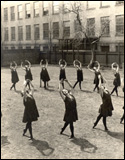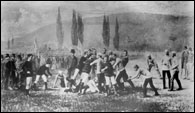Alchemy in the archives
McGill Senior Archivist Gordon Burr unlatches what appears to be a misshapen trombone case and slowly pries open its shell. Inside, a plush compartment cradles a wide scroll that is tethered to a thick, disk about the size of a tea saucer. A student assistant steadies the heavy disk, which hangs precariously from the page like an anchor, while Burr extracts the parchment, handling it with the care usually reserved for a newborn.
But this baby is 150 years old. The "anchor" is the genuine seal of Queen Victoria embossed in wax, and the document it trails is the McGill Charter of 1852, the royal decree that transformed James McGill's fledgling Royal Institution for the Advancement of Learning into a private university. It is the jewel of the McGill University Archives, a delicate ensemble piece mortally vulnerable to acid, light, heat, humidity and, of course, laceration. "Yes," Burr exhales, finally, once he's safely transferred the oversized document to its wooden display frame, "we do have to be careful."
But for all its museum-quality majesty, the Archives' pre-eminent piece shares at least one trait with the holdings that fill most of its other 17,000 boxes: it's a working document. Within the Charter's four-page thicket of old-fashioned English is written McGill's still-binding mandate, the University's rights and obligations. The department's director and University Archivist, Johanne M. Pelletier, explains that the Charter's duality--an essential document that also tells some part of McGill's story--is typical of the collection. "It's rare that the Archives promotes history alone," she explains. "Our central mandate is to ensure the preservation of records of long-term legal and historical value to the University."
The primary format has been paper. The Archives has 6,000 metres of it--a stack that would stand taller than Mount Kilimanjaro. The reams of student records, financial statements, personnel records, legal papers, meeting minutes, memos, and architectural plans are considered essential documentation and maintained with vigilance by Archives staff. Especially revealing, Pelletier notes, are the principals' papers, which touch on every donation, decision and achievement made during their tenures. "Because decision-making was more centralized in the past, we see virtually everything about the University reflected in these papers," she says. "They provide a broad brush stroke of University life."
If essential documents form the Archive's skeleton, then publications, photos and memorabilia are the flesh on its bones. There are complete volumes of publications, from the Gazette (1873-1890) to the Fortnightly (1892-1898) and the Outlook (1898-1907) to the Martlet (1908-1911) and the Daily (1911-present); and periodicals, including the University Magazine (1900-1919) and the McGill News, now 83 years old. Each edition of "Old McGill," the venerable yearbook first published in 1898, is a trove of memories.
 Modern Dance, 1923
Modern Dance, 1923McGill Archives |
|
Some 30,000 photos grace the Archives, from ancient daguerrotypes to digital prints, from quotidian portraits to genuine classics. The first six graduates in Applied Science, class of 1873, plying their trades around a work bench. Passionate students protesting the Vietnam War with homemade banners. A somber gathering of the first female graduates, bound in the soaring necklines and bustles of the late 19th century. The Modern Dance class of 1923, reaching for the heavens in breezy garments that celebrate the end of Victorian and Edwardian era confines. The 1899 Banjo Club, instruments cocked and ready. Members of the Canadian Officers Training Corps preparing for the Great War.
 McGill and Harvard football game, 1874
McGill and Harvard football game, 1874McGill Archives |
|
There's a print of the historic 1874 football contest between McGill and Harvard, considered the first to be played under modern rules. It's a fine composite work of noted chronicler William Notman. Before photographic technology allowed "action" shots, Notman achieved the desired kinetic effect by capturing each of the footballers in his studio, then painstakingly assembling them into a coherent scrum framed by an illustrated crowd milling unrealistically close to the play. Art and history collide in the Archives.
"We're also interested in the unofficial cultural records of the University--scrapbooks, journals, exams, course notes, doodling in course notes," Pelletier says. "It's important to have some samples that give a glimpse into what happened inside and outside of the classroom at McGill during different eras."
Their small collection of ephemera includes a 1861 lecture card, required for admittance to class in a more mannered era; playbills from Red & White Reviews and programs from Winter Carnivals; an LP recording from the wildly popular 1957 theatrical production of My Fur Lady.
"We're not the Antiques Roadshow," Burr says. "But the memorabilia really brings our history alive."
The Archives were established in 1962, when outgoing Principal F. Cyril James appointed Alan Ridge to appraise and consolidate the vast stores of documents that had collected in file cabinets, laboratory cupboards and custodian's closets across campus over the previous 140 years.
These days, faculty and staff, Pelletier reports happily, know which records to keep and, importantly, which not to keep. "We don't have a crystal ball, but we do have a solid knowledge about what McGill, as both an educational institution and a corporation, needs to keep as essential records – to provide evidence of accountability, proof that we did what we promised."
The Archives has a secure, dark, climate-controlled environment, a kind of wine cellar for fragile documents. Rows of tidy shelves are well documented; each box is clearly labeled and logged in a database. Paper is house in acid-free boxes to slow the aging process. Microfilm, audiotapes, video and film footage are stored in containers that conform to each format's special needs. Each year Archives blends another 1,800 boxes of materials from the McGill hinterlands into the system. "A lot of intellectual footwork goes into creating such an organized archive," Burr says. "It doesn't come to us neatly in boxes with nice labels."
The Archives staff occasionally make house calls, as they did this summer to the basement of physical plant. There documents languished in unmarked boxes, piles and random cabinets throughout a warren of subterranean rooms. Rolled-up architectural plans were scattered like upended cigarettes, often sharing space with cleaning supplies or cast-off computers. "A real slice of life," Burr says. "Typically there's someone in every office who has been there for 20 or 30 years and who knows where everything is. But when they leave, the knowledge leaves with them. Then we're asked to organize it so anyone can find the plans they're looking for."
The trick, Burr says, is creating a system that is simple to access but that doesn't supplant the old system entirely. "If we don't understand how they cataloged records in the past, we won't be able to interpret them."
McGill doctoral candidate and legal historian Ian Pilarcyzk spent a year in the Archives, trolling for any mention of the Faculty of Law that he could use to piece together A Noble Roster: 150 Years of Law at McGill. "I went through every issue of everything in print," Pilarczyk recalls. "There's no other way to do it."
Staff are happy to help researchers, from the student working up a term paper to the historian producing a scholarly work to the journalist exploring a lead or the amateur genealogist whose family tree might just grow through the Roddick Gates.
For Pilarczyk, a mix of perseverance, luck and expert guidance unlocked the door to 150 years of facts, figures, names, dates and, most significantly, good stories that he could weave into his history project.
"I've come to see archivists as unsung heroes," Pilarczyk says. "It sounds a bit melodramatic, but there wouldn't be people like me writing history if there weren't archivists preserving it. We tend to think that it's just putting things in boxes. But it's so much more."
The Archives' collection is impressive, but there are very few artifacts of student life at McGill. The department relies on contributions from alumni and their descendents to fill in the considerable gaps. One recent arrival is an exhaustive collection of letters from the family of Annie Holiday Pelletier, one of McGill's first female students. Included are letters she wrote to her parents during her time as an undergraduate, from 1895 to 1899.
"The letters open a significant window on the University at that time, and inform us about family and religious life in plain language," says Johanne Pelletier (no relation). "There are so few sources in which students speak for themselves about life on campus, and this is one of the most revealing and beautifully crafted parts of the Archives."
Ian Pilarczyk extended his regular personal forays onto eBay, the Internet auction site, to include searches for McGill artifacts. Budgeting a few dollars for the purpose, he's thus far purchased a series of classic postcards, some rare intercollegiate football game programs and a 1913 McGill keychain that was owned by a young freshman named Wilson who died the next year fighting in France. Pilarczyk plans to donate it all to the Archives "This is purely a work of love," he says. "It's a good cause--McGill's patrimony, an important thing to preserve."
"McGill's history is more than just the obvious," Pilarczyk continues. "It's the day-to-day activities of student life, which decades from now people may find very interesting. I wish that 100 or 150 years ago, more people had said, 'You know what, it may be really interesting to people to realize what students were doing in the 1870s.'
"How many people inherit old McGill items from relatives or friends--old class notes, textbooks, t-shirts, memorabilia--and just chuck them? How many think to call the Archives first?"
Says Burr: "Every acquisition has at least one thing in common with the rest: someone realizes it has long-term value."
The rest is history.
A longer version of this article first appeared in the Fall 2002 McGill News. Are you related to James McGill? Visit the Archives website www.archives.mcgill.ca to find out. On the site you'll find FAQs and have access to over 7,000 photos, documents and ephemera. Coming soon: streaming audio of McGill music, video of theatre productions and campus events.

